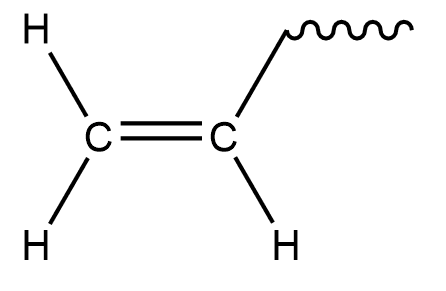
Which of the following is a vinyl group?
(A) \[\left( {{\text{C}}{{\text{H}}_3}} \right){\text{CH}} - \]
(B) \[{\text{HC}} \equiv {\text{C}} - \]
(C) \[{{\text{H}}_2}{\text{C}} = {\text{CH}} - {\text{C}}{{\text{H}}_2} - \]
(D) \[{\text{C}}{{\text{H}}_2} = {\text{CH}} - \]
Answer
121.2k+ views
Hint: We know that unsaturated hydrocarbons in which carbon atoms are bound to each other with double bonds are called alkenes. If one hydrogen atom from such compounds is removed, we can get a totally different compound.
Complete step by step answer:
Vinyl groups are also called ethenyl. It is basically ethylene with one less hydrogen atom less.
So, if we remove 1 Hydrogen from ethylene we get,

Hence \[{\text{C}}{{\text{H}}_2} = {\text{CH}} - \]is a vinyl group.
So, the correct option is D.
Additional information: Vinyl groups need to be activated by some other group for enhanced reactivity. Activation increases the polarity of the bond and hence also increases reactivity. Vinyl groups are often found as intermediates in preparation of various organic compounds. In hydrohalogenation of alkynes i.e. (addition of hydrogen and halogen) vinyl groups containing intermediates are formed. For example –
\[\begin{gathered}
{\text{H}} - {\text{C}} \equiv {\text{C}} - {\text{H + H}} - {\text{Br }} \to {\text{ [C}}{{\text{H}}_2} = {\text{CH}} - {\text{Br] }} \to {\text{ C}}{{\text{H}}_3} - {\text{CH}} - {\text{B}}{{\text{r}}_2} \\
{\text{ethyne vinyl bromide dibromo ethane}} \\
\end{gathered} \]
In the above reaction, when added to ethylene, vinyl intermediate is formed. Which on further reaction gives dibromo ethane. This reaction is used in preparation of secondary alkyl halides.
Vinyl groups are known to polymerize faster when a catalyst is used. Polymers formed are called vinyl polymers. However, these polymers do not contain any vinyl groups.
On industrial level manufacturing of polyvinyl chloride, vinyl chloride is used as a starting compound which contains vinyl groups.
Note: Out of the given four options, A is a tertiary butyl group and C option is an allylic group. Allylic group is often confused with vinyl group. We can remember it in a way that vinyl is formed when ethylene loses one hydrogen atom.
Complete step by step answer:
Vinyl groups are also called ethenyl. It is basically ethylene with one less hydrogen atom less.
So, if we remove 1 Hydrogen from ethylene we get,

Hence \[{\text{C}}{{\text{H}}_2} = {\text{CH}} - \]is a vinyl group.
So, the correct option is D.
Additional information: Vinyl groups need to be activated by some other group for enhanced reactivity. Activation increases the polarity of the bond and hence also increases reactivity. Vinyl groups are often found as intermediates in preparation of various organic compounds. In hydrohalogenation of alkynes i.e. (addition of hydrogen and halogen) vinyl groups containing intermediates are formed. For example –
\[\begin{gathered}
{\text{H}} - {\text{C}} \equiv {\text{C}} - {\text{H + H}} - {\text{Br }} \to {\text{ [C}}{{\text{H}}_2} = {\text{CH}} - {\text{Br] }} \to {\text{ C}}{{\text{H}}_3} - {\text{CH}} - {\text{B}}{{\text{r}}_2} \\
{\text{ethyne vinyl bromide dibromo ethane}} \\
\end{gathered} \]
In the above reaction, when added to ethylene, vinyl intermediate is formed. Which on further reaction gives dibromo ethane. This reaction is used in preparation of secondary alkyl halides.
Vinyl groups are known to polymerize faster when a catalyst is used. Polymers formed are called vinyl polymers. However, these polymers do not contain any vinyl groups.
On industrial level manufacturing of polyvinyl chloride, vinyl chloride is used as a starting compound which contains vinyl groups.
Note: Out of the given four options, A is a tertiary butyl group and C option is an allylic group. Allylic group is often confused with vinyl group. We can remember it in a way that vinyl is formed when ethylene loses one hydrogen atom.
Recently Updated Pages
Classification of Drugs Based on Pharmacological Effect, Drug Action

Types of Solutions - Solution in Chemistry

Difference Between Alcohol and Phenol

JEE Main Participating Colleges 2024 - A Complete List of Top Colleges

JEE Main Maths Paper Pattern 2025 – Marking, Sections & Tips

Sign up for JEE Main 2025 Live Classes - Vedantu

Trending doubts
JEE Mains 2025: Check Important Dates, Syllabus, Exam Pattern, Fee and Updates

JEE Main Login 2045: Step-by-Step Instructions and Details

JEE Main Chemistry Question Paper with Answer Keys and Solutions

JEE Main Exam Marking Scheme: Detailed Breakdown of Marks and Negative Marking

JEE Main 2023 January 24 Shift 2 Question Paper with Answer Keys & Solutions

JEE Main Chemistry Online Mock Test for Class 12

Other Pages
NCERT Solutions for Class 12 Chemistry Chapter 6 Haloalkanes and Haloarenes

NCERT Solutions for Class 12 Chemistry Chapter 1 Solutions

NCERT Solutions for Class 12 Chemistry Chapter 2 Electrochemistry

JEE Advanced Marks vs Ranks 2025: Understanding Category-wise Qualifying Marks and Previous Year Cut-offs

NCERT Solutions for Class 12 Chemistry Chapter 7 Alcohol Phenol and Ether

NCERT Solutions for Class 12 Chemistry Chapter 8 Aldehydes Ketones and Carboxylic Acids




